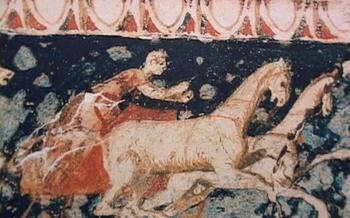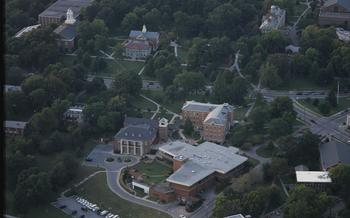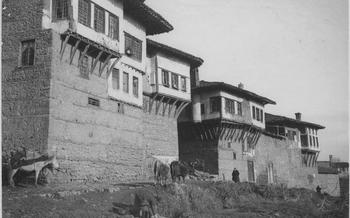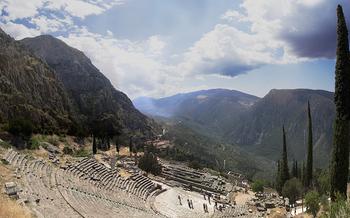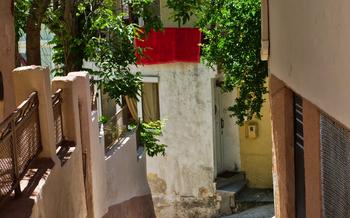
Vergina Aigai, Royal Tombs and Museum
- Vergina, the Ancient Capital of Macedon
- The Vergina Museum
- Getting to Vergina
- What to See in the Vergina Museum
- The Importance of Vergina
- The History of Vergina
- The Archaeological Site of Vergina
- The Royal Tombs of Aigai
- The Gold Diadem of Philip II: A Symbol of Power and Prestige
- The Ivory Head of a Young Man
- The Silver Rhyton in the Shape of a Deer's Head
- The Gold Larnax of Alexander IV
- Insider Tip
Vergina, the Ancient Capital of Macedon
Vergina, a small town in northern Greece, holds a significant place in history as the ancient capital of the powerful kingdom of Macedon. Founded in the 4th century BC by King Philip II, Vergina served as the Macedonian capital for over 200 years, during which time it grew into a thriving metropolis and a center of culture and power.
In the 4th century BC, Macedon, under the rule of Philip II, emerged as a dominant force in the Greek world. Philip II's ambitious military campaigns and his innovative reforms transformed Macedon into a formidable power, laying the foundation for the conquests of his son, Alexander the Great. Vergina, as the seat of Macedonian power, played a crucial role in these developments, witnessing the rise and fall of one of the most influential kingdoms in ancient history.
The archaeological discoveries made at Vergina, particularly the royal tombs, have shed new light on the life and culture of ancient Macedon. These discoveries have provided tangible evidence of the wealth and power of the Macedonian kingdom, as well as valuable insights into the daily lives of its rulers and citizens.
Vergina's historical significance and the remarkable archaeological findings have earned it recognition as a UNESCO World Heritage Site. This prestigious designation highlights the site's outstanding universal value and its importance for understanding the history and culture of ancient Greece.
Moreover, Vergina stands as a symbol of Macedonian heritage and identity. For the people of Greece and the region, Vergina represents a tangible connection to their glorious past and a source of pride in their cultural heritage. The site's historical and archaeological treasures continue to inspire and fascinate visitors from around the world, offering a glimpse into the grandeur and achievements of ancient Macedon.
The Vergina Museum
The Vergina Museum is a must-see for anyone interested in ancient Macedonian history and culture. It houses the artifacts excavated from the royal tombs of Vergina, including gold jewelry, weapons, and other objects. The museum also features interactive exhibits that provide visitors with a deeper understanding of Macedonian culture.
The museum is divided into several sections, each of which focuses on a different aspect of Macedonian history and culture. The first section introduces visitors to the history of the Macedonian kingdom, from its foundation by King Philip II in the 4th century BC to its conquest by the Romans in 168 BC. The second section focuses on the life and achievements of Alexander the Great, one of the most famous Macedonian kings. The third section displays the artifacts from the royal tombs, including the gold diadem of Philip II and the gold larnax of Alexander IV.
The museum also has a research and conservation center, where scholars work to study and preserve the artifacts from Vergina. The center is open to the public, and visitors can learn about the latest research on Macedonian history and culture.
Getting to Vergina
Vergina is located in northern Greece, in the region of Macedonia, near the city of Thessaloniki. It is easily accessible by car, bus, or train. By car, take the A2 motorway from Thessaloniki and follow the signs to Vergina. The journey takes about 1 hour and 30 minutes. By bus, take the KTEL bus from Thessaloniki to Veria, and then change to a local bus to Vergina. The journey takes about 2 hours and 30 minutes. By train, take the train from Thessaloniki to Veria, and then change to a local bus to Vergina. The journey takes about 3 hours. There is ample parking available at the Vergina Archaeological Site.
What to See in the Vergina Museum
The Vergina Museum is home to a vast collection of artifacts from the royal tombs, offering visitors a glimpse into the opulence and craftsmanship of ancient Macedonia. Among the most notable exhibits are the gold diadem of Philip II, an exquisitely crafted wreath adorned with scenes from Greek mythology; the gold larnax of Alexander IV, a gold-covered coffin containing the remains of Alexander the Great's son; the ivory head of a young man, a serene and enigmatic sculpture possibly depicting a young Alexander the Great; and the silver rhyton in the shape of a deer's head, a unique and beautiful vessel used for pouring libations or drinking wine. These stunning artifacts, along with numerous other treasures, provide a tangible connection to the rich history and cultural heritage of ancient Macedon.
The Importance of Vergina
The discovery of the royal tombs and the artifacts within them shed new light on the life and culture of ancient Macedon. Previously, much of what was known about Macedon came from the writings of Greek historians, who often had a biased view of the kingdom. The tombs, however, provided direct evidence of the wealth and power of the Macedonian kingdom, and helped to dispel some of the myths and misconceptions that had surrounded it.
The excavations at Vergina also contributed to our understanding of Greek history as a whole. The tombs provided evidence of the close cultural and artistic ties between Macedon and the rest of Greece, and helped to bridge the gap between the classical and Hellenistic periods. The discovery of the tombs also helped to raise the profile of Macedon, which had often been overshadowed by its more famous southern neighbor, Athens.
The History of Vergina
Vergina, once known as Aigai, holds a rich and storied past, deeply intertwined with the rise and fall of ancient Macedon. Founded in the 4th century BC by the ambitious King Philip II, Vergina swiftly ascended as the pulsating heart of the Macedonian kingdom, a beacon of power and prosperity.
Over two centuries, Vergina stood as the majestic capital, a testament to Macedonian prowess. Within its walls, kings ruled, armies marshaled, and the seeds of civilization flourished. Vergina's strategic location at the crossroads of trade routes further cemented its importance, transforming it into a vibrant hub of commerce and cultural exchange.
However, the tides of history shifted dramatically in 168 BC when the relentless Roman legions, under the command of Lucius Aemilius Paullus, breached Vergina's defenses, marking the end of Macedonian independence. Despite this setback, the city retained its significance, serving as a provincial capital and a bastion of Hellenistic culture under Roman rule.
As centuries rolled by, Vergina's fortunes continued to ebb and flow, mirroring the tumultuous events that swept across the region. It weathered the storms of time, enduring Byzantine rule, Ottoman conquest, and the struggles for Greek independence.
Today, Vergina stands as a living testament to its storied past, a place where the echoes of ancient grandeur still resonate. Its archaeological treasures, unearthed from the depths of time, invite us on a journey to rediscover the splendor and significance of this once-mighty capital.
The Archaeological Site of Vergina
In addition to the royal tombs, Vergina is also home to an extensive archaeological site that offers a glimpse into the grandeur of the ancient city. The ruins of the royal palace, once the seat of power for the Macedonian kings, are particularly impressive. With its grand courtyards, elaborate mosaics, and well-preserved frescoes, the palace provides a tangible connection to the opulent lifestyle of the Macedonian elite.
Other notable structures within the archaeological site include the theater, where plays and performances were held, and the agora, the bustling marketplace where people from all walks of life congregated. Ongoing excavations at Vergina are continuously revealing new insights into the city's past, uncovering artifacts and structures that shed light on the daily lives of the ancient Macedonians. Whether you're a history buff, an archaeology enthusiast, or simply someone who appreciates the beauty of ancient ruins, the archaeological site of Vergina is a must-visit destination.
The Royal Tombs of Aigai
The Royal Tombs of Aigai are one of the most important archaeological discoveries of the 20th century. They were discovered in 1977 by Greek archaeologist Manolis Andronikos and are located within the archaeological site of Vergina, the ancient capital of Macedon. The tombs are intact and belong to Philip II, his son Alexander IV, and other members of the royal family. They contain a wealth of artifacts, including gold jewelry, weapons, and armor, which provide valuable insights into the life and culture of ancient Macedon. The tombs are a UNESCO World Heritage Site and are considered to be one of the most important archaeological sites in Greece.
The Gold Diadem of Philip II: A Symbol of Power and Prestige
Among the treasures discovered in the royal tombs of Vergina, the gold diadem of Philip II stands out as a masterpiece of ancient craftsmanship. This exquisitely crafted gold wreath is adorned with intricate scenes from Greek mythology, including the battle between the gods and the giants, and the birth of Athena from the head of Zeus. The diadem is a testament to the skill of ancient Greek goldsmiths and the wealth and power of the Macedonian kingdom.
It is believed that Philip II wore the diadem as a symbol of his authority and prestige. The diadem's elaborate decoration and the scenes depicted on it suggest that it was also a symbol of Philip II's connection to the gods and his claim to legitimacy as the ruler of Macedon. The discovery of the diadem in the tomb of Philip II has provided valuable insights into the life and reign of this powerful Macedonian king.
The Ivory Head of a Young Man
Among the many treasures discovered in the royal tombs of Vergina, the ivory head of a young man stands out as a masterpiece of ancient Greek sculpture. Carved from a single piece of ivory, the head depicts a young man with a serene and contemplative expression. His hair is carefully arranged in soft waves, and his eyes, though inlaid with precious stones, have been lost to time. Despite this, the head retains a remarkable sense of realism and emotional depth.
The identity of the young man portrayed in the ivory head is uncertain, but many scholars believe that it is a portrait of Alexander the Great as a child. The head bears a striking resemblance to other known portraits of Alexander, and it was found in the same tomb as the gold diadem of Philip II, Alexander's father.
The ivory head of a young man is a testament to the skill and artistry of ancient Greek sculptors. It is a rare and precious artifact that provides a glimpse into the life and appearance of one of history's most famous figures.
The Silver Rhyton in the Shape of a Deer's Head
Among the treasures discovered in the royal tombs of Vergina, the silver rhyton in the shape of a deer's head stands out for its unique beauty and craftsmanship. This exquisite vessel, crafted from pure silver, depicts a majestic deer with intricately detailed antlers. The deer's head is rendered with remarkable realism, capturing the animal's alert expression and graceful posture.
The rhyton, which was used for pouring libations or drinking wine, is a testament to the skill and artistry of ancient Macedonian craftsmen. Its elegant form and intricate decorations showcase the high level of craftsmanship that existed in the Macedonian kingdom. The deer's head motif, often associated with the hunt and the wilderness, may have held symbolic significance for the Macedonian rulers, who were known for their prowess as hunters and their close connection to nature.
This remarkable artifact, along with the other treasures from the royal tombs of Vergina, provides valuable insights into the life and culture of ancient Macedon. It is a powerful reminder of the wealth, power, and sophistication of this ancient kingdom, which played a pivotal role in shaping the course of Greek history.
The Gold Larnax of Alexander IV
Among the many treasures discovered in the royal tombs of Vergina, the gold larnax of Alexander IV stands out as a particularly significant and poignant artifact. This exquisitely crafted coffin, made of pure gold and adorned with intricate engravings, once held the remains of Alexander IV, the young son of Alexander the Great.
The larnax was found intact, its contents remarkably well-preserved. Inside, archaeologists discovered the bones of a young boy, along with a wealth of grave goods, including gold jewelry, weapons, and other objects. These findings provided conclusive evidence that the tomb belonged to Alexander IV, who was murdered at the age of 13 by his uncle, Cassander.
The larnax itself is a masterpiece of ancient craftsmanship. Its exterior is decorated with elaborate scenes from Greek mythology, depicting the exploits of Hercules and the Labors of Theseus. The intricate details and symbolism of these engravings offer a glimpse into the beliefs and values of the ancient Macedonians.
The discovery of the gold larnax of Alexander IV was a major archaeological breakthrough, confirming the existence of Alexander the Great's son and shedding new light on the complex and tragic history of the Macedonian royal family. This precious artifact stands as a reminder of the grandeur and fragility of ancient empires, and serves as a symbol of the enduring legacy of Alexander the Great.
Insider Tip
For an optimal experience, plan your visit to the Vergina Museum on a weekday to avoid the throngs of visitors that typically descend on weekends. This will allow you to leisurely explore the exhibits and delve into the captivating history of Vergina without feeling rushed or jostled. Take your time to carefully examine the artifacts, read the informative panels, and immerse yourself in the stories they tell.
To further enrich your journey, consider combining your visit to the Vergina Museum with a trip to the nearby town of Veria. This historic town, located just a short drive from Vergina, boasts a wealth of cultural treasures, including Byzantine churches, Ottoman mosques, and a vibrant central square. Explore the charming streets, visit the fascinating museums, and savor the delicious local cuisine. By combining these two destinations, you'll gain a deeper understanding of the rich history and diverse heritage of this captivating region.
